| Columns Retired Columns & Blogs |
Thank you for the review.
I know you didn't try this but I wonder how these would integrate with the newer Kef LS50 Wireless II active speakers?
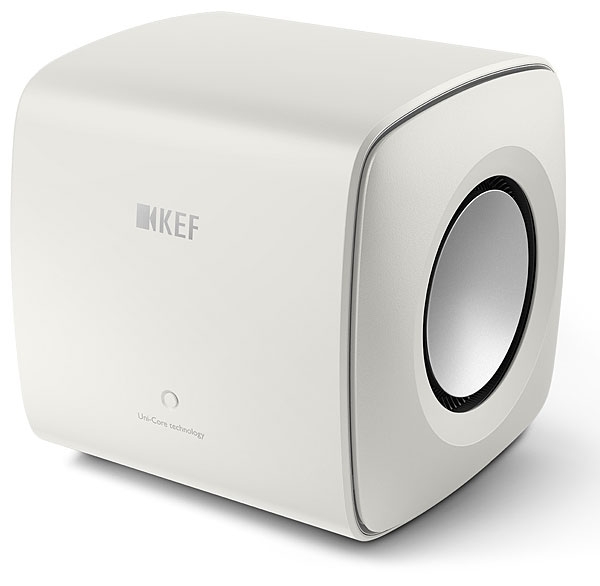
One of my favorite great recordings is 1994's Madar (24/44.1 MQA FLAC ECM/Tidal), recorded by ECM conjurer Manfred Eicher and performed by saxophonist Jan Garbarek, Tunisian oudist Anour Brahem, and tabla player/percussionist Ustad Shaukat Hussain. When I listen to Madar with my eyes closed, its complex palette of tones, exotic aural textures, and morphing tempos dance vividly before me. Its sounds convert to visual and tactile associations, which then morph into inspired reverie. How completely and effectively this well-recorded album presents itself is a good indicator of how accurate and well-balanced my sound system is.
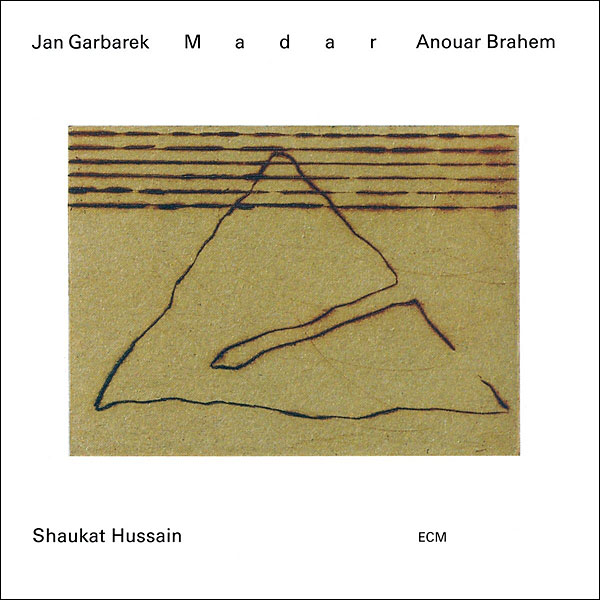
The above musings are intended to prepare you for my latest confession: Every loudspeaker I've ever owned failed to present music in a complete and properly balanced manner. Why? Because they rolled off too quickly in the lower frequencies. This includes the several pairs of Quad ESL-57 electrostatics; they made more bass than I thought they would and yet few audiophiles would describe the original Quads as full-range. It also includes my large Altec Lansing A5 Voice of the Theatre loudspeakers, which rolled off sharply at 60Hz, and my long-term reference Altec 604Es in Altec 612 cabinets, which rolled off lower but not low enough.
Then, of course, there is my three-decade love affair with the BBC LS3/5a. Every time I listen with these speakers, I pause to admire their midrange beauty and resolve, then pause a bit longer and sigh, wishing for more focused, structured sound below that exquisite midrange.
The first time I experimented with high-quality commercial subwoofers, I was using stacked Quad ESL-57s on Arcici stands. I don't remember the subwoofer brand, but I do remember that those two used subwoofers cost more than my two pairs of Quads. I had high hopes for this system, but I never got those large, expensive subs to blend with the Quads in a satisfying manner. I tried passive and active low- and high-pass filters, but the woofers always soiled the midrange.
For a bunch of years, I experimented with Ted Jordan's full-range aluminum-cone modules on open baffles. I added Panasonic ribbon tweeters and various Focal or Dynaudio woofers (in sealed, aperiodic, or transmission-line enclosures) and never once found a combination I could live with. But what I learned was invaluable. I discovered that, in order to achieve a correctly balanced character, a loudspeaker's high frequencies must not be more extended than its low frequencies, and vice versa. Every loudspeaker has what I call a geometric center to its power bandwidth; adding extension to the top or bottom tends to throw that power center off, making reproduction feel unbalanced.
The KEF KC62
My lifelong focus on midrange beauty forced me to accept some amount of bass deficiency and to stop thinking about low-frequency augmentation—until just a few months ago, when I received a press release for the new $1500 KEF KC62 subwoofer (footnote 1). Intuitively, I felt this little 10" cube (KEF calls it "football-sized") was scaled and designed just right for my listening room. Before the KEF sub arrived, I knew exactly where I would put it: out from the wall, centered between my speakers.
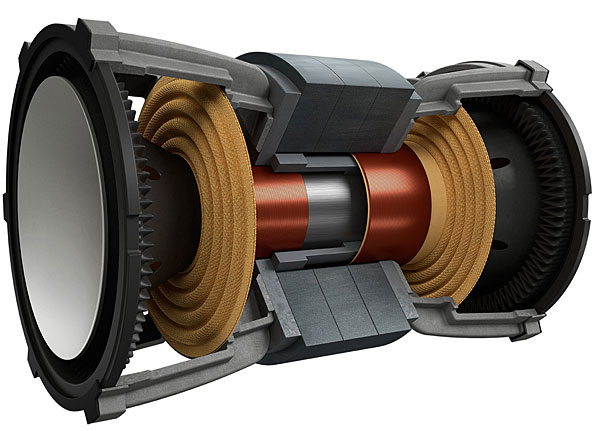
A cut-away diagram from KEF shows the KC62's force-canceling, 6.5" Uni-Core drivers with their concentrically sleeved voice-coils sharing a common pole-piece. The substantial magnets use the KC62's extruded aluminum enclosure as a heatsink.
Besides limiting undesirable cabinet movement, the KC62's bipole radiators double a single woofer's radiating area without demanding a larger box. According to KEF's website, the KC62's magnetically unified drivers employ a current-sensing feedback loop that counteracts voice-coil nonlinearities, "distortion reducing" P-Flex folded-cone-surrounds, and a variation on their new, much-discussed Meta-material Absorption Technology. Like KEF's LS50 Metas, the KC62 comes in either Carbon Black or Mineral White, both matte finishes.
When it arrived, I set the dense, 30.9lb KC62 on my desk so I could study it as I read the owner's manual. On its side-mounted control panel, I was impressed to see a single mechanical switch for choosing between five DSP room-placement profiles: Room (for positioning away from walls), Wall (for next to a wall but not in a corner), Corner, Cabinet (near a corner, inside a cabinet), and Apartment (which reduces the level of the KC62's lowest frequencies).
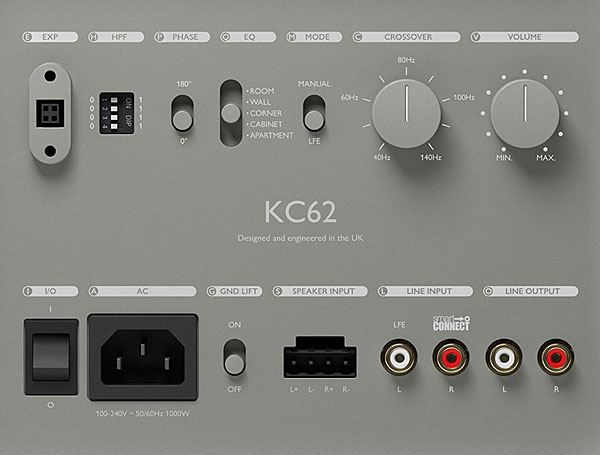
The KC62 includes line-level (RCA) and speaker-level inputs (Phoenix connector) and a variable (40Hz–120Hz) high-pass–filtered (HPF) line-level (RCA) output; the main speakers, then, can be driven directly (full-range) or first passed through the KC62 via the line-level inputs and outputs to roll off the low end to blend with the sub. These high-pass turnover points are set, between 40Hz and 120Hz (or bypass), via four panel-mounted DIP switches. The woofer's output level and low-pass turnover frequency are set with matching, calibrated knobs. There is also a 0°/180° phase-inversion switch and an expansion port that accepts KEF's (optional) KW1 wireless adapter ($200).
Setting up
The main thing to remember about the KEF KC62 is that it is a 10" cube, which is really small, and really small is easier to position than big or—especially—really big.
If I had two KC62s I would have placed them firing sideways near the walls (but away from the corners) directly behind my speakers. In that position I would expect them to disappear entirely, leaving me to experience some increase in soundstage dimension and ambience retrieval.
But I had only one sub. Earlier, I wrote that I knew where I'd put it, but before I put it there, I wanted to assess its power in other locations. First, I put it in a corner, then behind one speaker, then against a wall next to my listening position (which sounded quite good). I ended up with it centered between my speakers about 3' from the front wall. I kept the DSP room placement switch on Room.
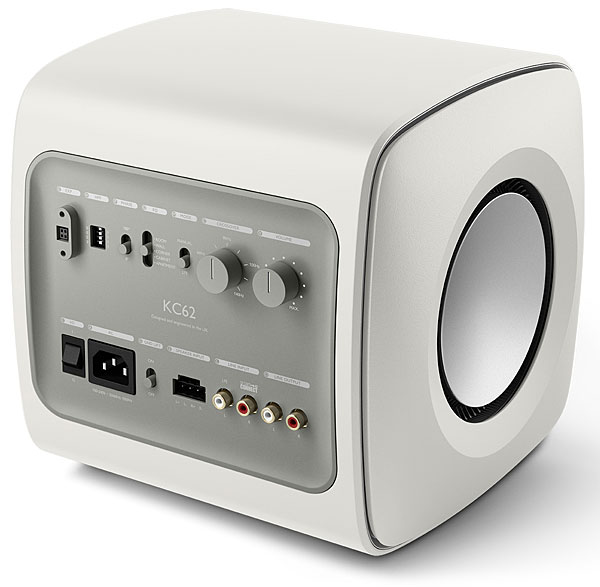
Placing a subwoofer in a corner maximizes room gain thereby minimizing cone excursion for a given volume, potentially lowering distortion. Unfortunately, all of my experiments with corner placement had unruly out-comes. Corner placements seemed to expose or exacerbate formerly hidden room issues.
With Falcon LS3/5a
The first speakers I tried were my (new old) reference Falcon LS3/5a (Gold Badge Edition). I wanted to orchestrate their satellite-to-sub merger as smoothly and inaudibly as possible, so before I listened, I did some measuring.
In my room, the Falcon LS3/5a's sit on 24" Sound Anchor stands, 70" apart with 13" between their cabinet backs and the front wall. In that position, their midrange tone is superb, and they measure about equal in level at 100Hz, 1kHz, and 10kHz. I used that level as my measurement baseline. The Falcons begin rolling off sharply at 80Hz and show a narrow 6dB dip at 160Hz. I was curious to see if the new KEF sub could pull the dip up while flattening the 40Hz to 200Hz range.
My method was to patiently adjust the KC62's output and low-pass turnover point while plotting frequency response graphs using 1/3-octave warble tones from Stereophile's Editor's Choice test CD and the excellent but now-discontinued "Decibel: dB Meter" app for the iPhone. My measurements were taken from chest level in my normal listening position about 7' from both speakers. I dot-plotted my with-sub measurements on log frequency and linear (decibel) amplitude graphs, directly over my measurements made without a subwoofer.

Thank you for the review.
I know you didn't try this but I wonder how these would integrate with the newer Kef LS50 Wireless II active speakers?

Perhaps it would serve to illuminate the more general standpoint / advantages of mono vs. stereo subbing.
PS- Another great review!

My second system, has stereo subs, much better than a single, and let me say there is "stereo" down there also on many discs.
I also found that the mains sound better not going through the subs HP xover, but sounds better direct from the source. Where through the subs HP xover it's sounded a tad sterile/hard in the mids/highs (many subs opamps in the signal path perhaps?).
Cheers George

" but sounds better direct from the source."
Bingo ! George.
Me too, I've found there is substantial stereo effect reproduced by L & R active subs.
I've even finally added the third active sub for the middle L+R channel.
Why, for obvious reason:-
Most most, if not all, concert halls/auditorium get an array of microphones overhanging the performance podium, covering L, R & L+R channels.
So 3 subs are NEEDED to reproduce the music & spatial/reverberation picked the lower frequency from 200Hz & below by the mics !!!!!
YES, that's exactly what I've found out years back when I installed my first active sub - hooked up DIRECT to the amp. Do NOT go thru any outboard sub X-overs which only screw up the sound, IMO.
In my case, ALL my 3 subs are hooked up DIRECT to my design/built tube phono-preamp which I installed discrete outputs for my subs.
Why need to get an outboard electronic sub X-over unit when there is already low-cut adjustable filter built in any active sub. ??
More redundant electronics make more harmonic, intermodulated & phase distortion. This is physics.
Listening is believing
Jack L

unlike, say, the late, unlamented Sunfire subwoofer.
For decades now, I have been a fan of the small speakers + sub combination. It's been a long time since I had a place where I could set up large, full-range speakers. In my opinion, for almost all kinds of music, you're not really "getting it" if your reproduction system quits at 70 Hz. You're hearing the second harmonic of the bass, not the fundamental.
Admittedly, getting a sub to play nice with the main speakers is not easy. No doubt lots of audiophiles feel that they have been forced to choose between lumpy, boomy bass and no bass . . . and have elected to go with the latter. But, as Herb Reichert's review shows, it can be worth the effort to get the combination right.
That said, one still must be satisfied with less than bone crushing loudness and in modest sized rooms. There is "no replacement for displacement." If you want the sense of scale of symphonic music, you need big speakers.
But that's a trade off lots of folks can live with.

......need big speakers." quoted dc_bruce.
Sorry, I beg to disagree to yr above statement.
With active subs (I got for L, R & L+R), No "BIG speakers" are really NEEDED.
Given my large KEF 2-way bookshelvers mounted on spiked steel tripods, properely aligned acoutistically with my subs, it rocks my 700sq. ft basement audio den with cathedral pipe organ music & Tchaikovsky 1812 Overture & the like heavy stuffs, no no sweat !
Subs when PROPERLY aligned with the main loudspeakers, only ENHANCE the overall music performance, instead of dominating it.
How come I don't get any "lumpy, boomy bass" given my 3 subs (L, R & L+R) always switched ON ???
Even very hefty priced Wilson Audio huge top "full-range" models, still come with supplementary Wilson active subs ! So ????
NO loudspeakers, large or miniature, are technically "full range" enough to reproduce any realistic sub-bass frequencies down to 20Hz due to our ears' extremely low low efficiency down to below 30Hz relative to 4HKz, frequency of our ears' highest efficiency.
This is physics.
For better soundstaging, precison imaging, transient response & spatial envelopment, smaller size of the loudspeaker box the better due to minimum soundwave deflection from the box & its corners where large box fails big big time, IMO.
Listening is believing
Jack L

Mr.HR,
This is the first time that I've observed someone successfully set up Woofers.
I've never been able to make Subs disappear like you reported here.
Now, I'm figuring that this Manufacturer gave this Sub the useful adjustability and you seemed to possess the determination to persevere thru the process. You give me hope.
Room volume is an important variable, adjustable set points are critical.
but.
Loudspeaker sensitivity matching to the output of the Sub seems out of reach.
Working with Subs is more like Loudspeaker Design.
Now, our Mr. HR is achieving Transducer Skill-sets.
High End is a tricky business, you're proving that it's within reach.
You are raising the bar for all your peers.
Nice work !!!
Tony in 'Venice Florida

I am trying to evolve.
It's like my father always said, "Even the weeds are learning."
hr

Hi
Please don't try to scare off those potential sub customers, my friend.
Otherwise, KEF vendors, among many other sub suppliers, will hate you !
It is not that some rocket science.
What I've done for my subs was to feed square waves/triangular waves (absolutely NO sinewaves) from my signal generator, to the sub line input (setting its low-cut frequency to min.) from 20Hz up 10 say 200Hz, depending on the sub under test.
I measured the sound levels with my digital sound level meter, set to
C-weighting (-6dB@20Hz), fast response & peak level reading placed at my ears level at my sweet spot.
That's it.
Jack L

I doubt I could do any such thing.
Mr. HR just did a nice job of showing how to set-up one of these devices .
Wouldn't we old-schoolers typically just BUY a bigger loudspeaker system ?
This woofer is a cute little matching for the LS50, it's wife friendly and it can be adjusted so that the neighbour ( next door ) isn't bothered.
I'm getting the idea that if a person LOVES the LS50 and wants to keep it, this little woofer will extend it's lovability without making itself obviously known, it can disappear so the family will only notice that the whole rig is ever more beautiful. ( for a modest cost )
I'dve sold a ton of these if we had em available ( back in the good old days of LS3/5 , LINN KANN, Pro-Ac Tablette, Spica TC-50 -- 1985ish )
Tony in Venice Florida
ps. what are you using for digital should level measurements ?

Love my KC62 with Wharfedale Linton's and LRS'.

I'm a bit surprised that neither Herb's review nor the KEF manual for the KC62 describes how the "phoenix connector" is to be used for a speaker-level connection. I contrast this with the way the REL website goes into great detail about use of the Speakon connector and the hookup methods they prefer. As a subwoofer newbie, looking for something to "integrate" with my system (integrated amp) these details are important to me.